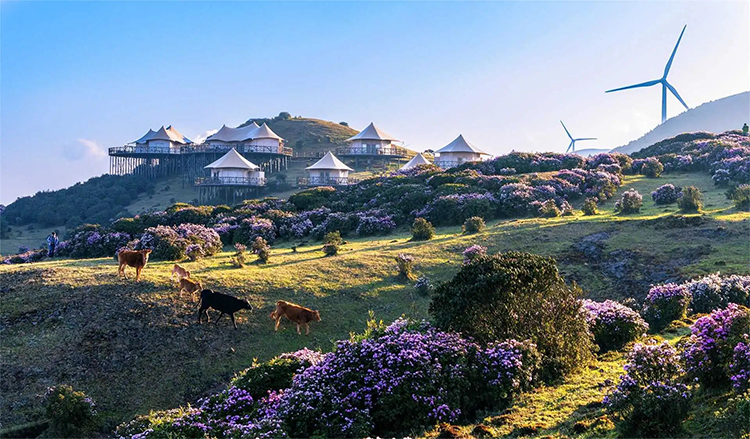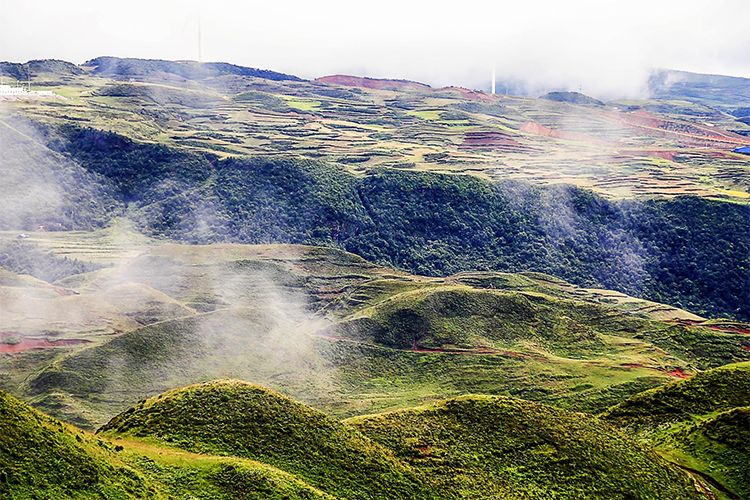Wumeng Grassland Travel Guide: High Mountain Rhododendrons, Cloud-Kissed Highlands and Yi Culture
Introduction
Driving up through the last veil of cloud, you suddenly find yourself before a living three-dimensional painting—Wumeng Grassland, a jade-green pasture set on the summit of the Yunnan-Guizhou Plateau. This is one of China’s closest mountain meadows to the sky: 100,000 mu of alpine grassland roll with the contours of the land, 40,000 mu of rhododendron forest erupts in pinks and purples in spring and summer, and the most mysterious gift is the occasional “Buddha’s Light”—a golden halo appearing in mist and rain. As the largest highland grassland in southwest China, Wumeng carries Red Army Long March memories and preserves centuries-old Yi pastoral traditions.
1. The soul of the cloud grassland: a double wonder of nature and culture
At about 2,500 meters altitude, the grandeur described by Chinese poets becomes three-dimensional. Known to local Yi people as “Axilisi,” the grassland’s core attractions are the triad of alpine meadows, rhododendron seas, and the Buddha’s Light phenomenon. From April to June, dwarf rhododendrons reach full bloom, creating rare vertical flower belts that stain the slopes across nearly a thousand meters of elevation. In summer the grass becomes a green ocean dotted with herds of grazing cattle and sheep. In autumn mornings, when sunlight pierces mist at the right angle, visitors on the viewing platform can sometimes find themselves surrounded by a multicolored halo with their own shadow at the center—an elusive phenomenon meteorologists call the Buddha’s Light, which occurs here more frequently than at Mount Emei because of the special terrain.
History is visible here as well: ruins of ancient courier stations recall the prosperity of the Ming–Qing Tea Horse Road; in 1935 Red Army troops passed through and, with the help of Yi locals, crossed the perilous Wumeng passes; villages scattered at the grassland edge still preserve wooden-stack houses and traditional hearth culture.
2. Pastoral seasons: when to see Wumeng at its best
The best visiting season runs from April, when rhododendrons start to bloom, to August, when the highland stays pleasantly cool. Each season has its own charm:
– Flower season (April–June): Over 20 species of wild rhododendron, including Rhododendron maddenii varieties, bloom in sequence from valley to summit, with the highest flower seas meeting the clouds.
– Summer cool season (July–August): Average daytime temperature around 18°C; evenings require a jacket. This is festival season—starlit camps and Yi Torch Festival events take place.
– Autumn and winter (November–March): The ski area opens, making Wumeng a rare southern alpine skiing destination; rime and frosted scenery resemble an ink painting.
To see Buddha’s Light, go to the viewing platform in the early morning just after mist and drizzle—spring and summer have the highest probability. Photographers favor sunrise, when morning light gilds the meadow and Yi shepherds drive flocks through thin fog—a picture-perfect scene.
3. Deep experiences: from horseback rides to bonfires
Wumeng is not for superficial sightseeing—these activities deepen the journey:
– Horseback tours: Local caravans offer 1–3 hour rides across flower fields to reach ancient courier station ruins.
– Mountain off-road: All-terrain vehicle routes challenge elevations up to 2,800 meters at the remote Emutang area, where wild Davidia involucrata (handkerchief trees) appear along the route.
– Intangible heritage workshops: In Pingdi Yi township learn wool felting techniques and sample freshly made buckwheat cakes with honey.
– Stargazing camps: Official campsites rent tents; the Milky Way is vivid in summer, and winter offers snow-fire bonfire nights.
Special note: the Lunar June 24 Torch Festival is a highlight—wrestling, horse racing, and mass Yi circle dances are staged. Visitors can join the traditional “blacken-your-face” blessing ritual.

4. Practical guide: transport and itinerary suggestions
Transport:
– Best by car: Rent a car at Panzhou high-speed rail station and drive about one hour to the south gate (navigate to “Wumeng Grassland No.1 Parking Lot”). Mountain roads have many switchbacks but are in good condition.
– Public transport: Daily shuttle buses run from Panzhou bus station to Pingdi township (two departures per day); change to the park shuttle after arrival.
Suggested routes:
– One-day highlights: Visitor Center → Heavenly Pool viewpoint (best spot for Buddha’s Light) → Ancient courier station ruins → Rhododendron sea → Ski area (summer alpine grass-ski slope).
– Two-day deeper trip: Add a Yi village homestay, Emutang hike (guide recommended), and a night of stargazing camping.
Practical info:
– Tickets: Adult ticket 60 RMB, includes the park environmental shuttle (mandatory); ski area fees charged separately.
– Accommodation: On-site three-star hotel and Yi-style guesthouses available; Yi homestays recommended (around 200 RMB/night with breakfast).
– Food: Highland mutton hotpot, buckwheat cakes, and buckwheat liquor are local specialties; a cluster of restaurants operates near the visitor center.

5. Traveler tips
– Altitude adjustment: Although under 3,000 meters, some visitors may experience mild headaches—avoid strenuous activity the first day.
– Packing: Even in summer bring a windproof jacket; sunscreen and sunglasses are essential.
– Avoid crowds: National Day and Torch Festival attract many visitors; enter before 8:00 a.m. for a quieter experience.
Standing on Wumeng’s summit you may understand the Yi song that sings “clouds are the mountain’s belt, flowers are the earth’s language.” There are no fenced exhibits here—only a natural symphony of land, sky, and culture. When smoke rises from Yi village hearths at dusk and the shepherd bells sound in the distance, you may recognize the same serenity written by the ancient Chinese poet Tao Yuanming. Pack your bag—this cloud grassland awaits to show you an authentic panorama of Chinese mountain life.


